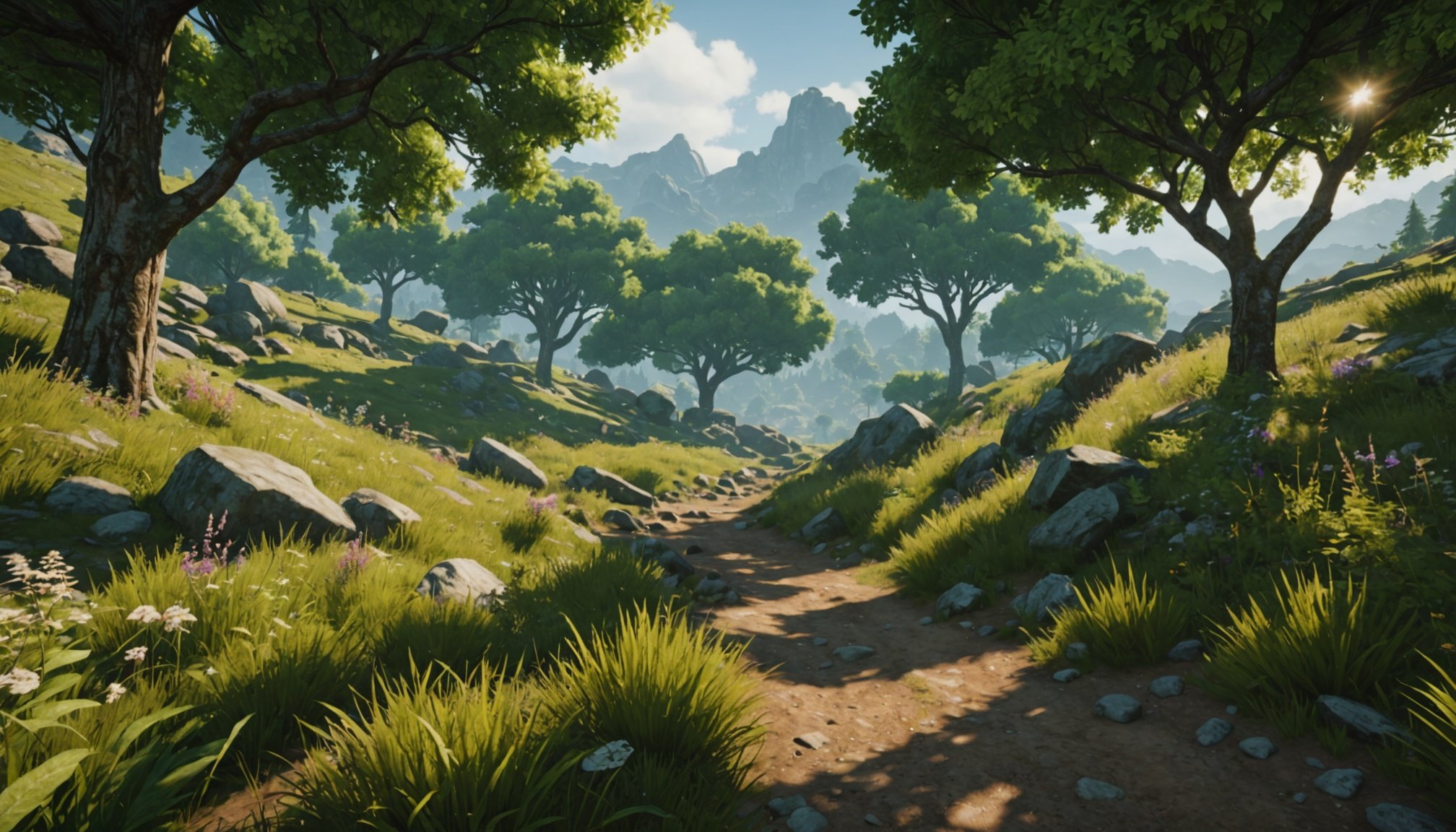Techniques for Rendering Realistic Trees
Creating realistic vegetation is essential in game design, especially within open-world games, as it significantly enhances the player’s experience. Tree modeling plays a crucial role here, providing diverse and natural looks for various tree species. For developers, choosing the right modeling technique can greatly influence the realism and efficiency of a game. LOD techniques are vital; they ensure that the level of detail in tree models adjusts dynamically based on the player’s distance, balancing performance and visual quality seamlessly.
Another key aspect is the use of shaders and textures to give trees a lifelike appearance. Intricate textures can simulate the complex surfaces found in nature, while shaders enhance these textures by adding the play of light and shadow. This creates depth and dynamism that mimics real-world trees. Together, these tools and methods in foliage detail help maintain the high standard of realistic vegetation that is expected in modern game design, enabling gamers to immerse themselves fully in virtual environments.
This might interest you : Boosting Realism: Leveraging AI to Transform Character Engagement in Social Simulation Games
Introduction to Realistic Vegetation in Game Design
Incorporating realistic vegetation is vital for elevating the gaming experience. Vegetation enhances environmental storytelling, allowing players to engage deeply with game worlds. In open-world games, where exploration is key, the authenticity of plants and trees can draw players further into the narrative, creating a seamless player immersion. Realistic vegetation paints a world where players can lose themselves, weaving a tale through the environments that they explore.
Advancements in game design techniques have revolutionised how these environments are crafted. Technological innovations enable the creation of intricate plant life that adheres to natural growth and behaviour patterns. By using sophisticated algorithms and state-of-the-art software, developers can simulate lifelike landscapes that react dynamically within the game environment. This continuous evolution in technology aids designers in pushing the boundaries of what is possible in vegetation design, ensuring that each element contributes meaningfully to the overall gaming experience.
Have you seen this : Transform Your Gaming Experience: Harness the Magic of 3D Audio for Unforgettable Soundscapes
In summary, realistic vegetation isn’t just a background element; it is integral to a player’s journey, offering invisible yet impactful layers to story and gameplay. As the industry grows, so does the potential for even greater fidelity in depicting natural environments.
Tools and Software for Vegetation Design
In the world of 3D modeling tools, technologies have evolved to support the detailed creation of vegetation assets essential in modern game design. These tools enable designers to craft everything from intricate leaves to towering tree structures, each contributing to the realism of the game environment. Popular tools include software like Blender, Maya, and 3ds Max, which offer extensive libraries and capabilities for vegetation creation.
Moreover, game engines play a significant role in handling the intricacies of complex vegetation. Game engines such as Unity and Unreal Engine provide the necessary frameworks and rendering capabilities required to seamlessly integrate vegetation into expansive game worlds. These engines are known for their robust features that enhance environmental interactions and visual fidelity.
Vegetation rendering techniques are also pivotal. Advances in rendering allow for lifelike presentations with features such as real-time shading and dynamic lighting, which bring out rich textures and subtle details. The collective use of these tools and techniques not only supports the creation of visually compelling landscapes but also enriches the gamer’s immersive experience.
Creating Lush Plant Life
In the realm of game design, crafting a diverse array of plant types, from flowers to shrubs, provides depth and realism to virtual worlds. Effective plant modeling strategies are essential for developers aiming to achieve this diversity. Utilising robust foliage systems within game engines allows for seamless integration, ensuring that each plant element interacts naturally with the game environment. These systems support dynamic organic growth patterns, enabling discoveries of new growth behaviours as players explore the game world.
Integrating various techniques, such as procedural generation, enables the simulation of realistic plant life cycles, adding to the immersive gaming experience. This approach provides efficiency, allowing developers to create diverse environments without manually modelling each plant.
To enhance organic growth, developers often rely on simulation algorithms mimicking real-world plant behaviour. These techniques ensure that virtual ecosystems respond dynamically to changes within the game environment, fostering a living, breathing world for players to explore. This blend of technology and artistry results in environments teeming with life, enhancing player immersion and narrative storytelling within games.
Case Studies of Successful Games
Delving into game development case studies uncovers how industry leaders have flawlessly implemented vegetation in open-world environments. Successful vegetation implementation can elevate gaming experiences, serving both as visual splendour and integral components of gameplay.
One notable example is “The Witcher 3: Wild Hunt,” known for its lush, expansive landscapes. The game deftly utilises vegetation rendering to create immersive environments, influencing how players navigate and interact with the world. Here, sophisticated algorithms generate lifelike vegetation, enhancing realism.
Another standout is “Horizon Zero Dawn,” which showcases dynamic foliage systems that respond to player actions and environmental changes. This seamless integration exemplifies how effectively crafting vegetation can enrich storytelling and gameplay mechanics.
These industry examples demonstrate the impact of innovation and artistry in game design. By analysing such successes, developers glean valuable insights into creative strategies that push technological boundaries. The lessons learned underscore the importance of a clear artistic vision paired with cutting-edge technology. As these case studies reveal, when executed effectively, realistic vegetation not only complements the game world but becomes a pivotal aspect of the gaming journey.
Terrain Texturing and Integration
In the landscape of game design, effectively executed terrain texturing is pivotal in crafting immersive environments. The art of blending materials plays a crucial role here, allowing designers to seamlessly integrate plants and trees into the terrain, ensuring a fluid visual experience. This cohesive integration is essential in constructing believable, lifelike environments that maintain player engagement.
A meticulous approach to terrain texturing involves carefully selecting textures that complement the surrounding vegetation features. This detail-oriented process helps in simulating the diverse ecosystems found in nature, adding to the overall realism of the game world. Additionally, special attention is given to elevation changes across terrains. By adeptly adapting textures to follow natural topography, developers can create visually compelling landscapes that enhance gameplay.
Moreover, the blending of materials ensures that vegetation transitions smoothly within the environment, avoiding harsh lines and unrealistic separations. This technique helps to emulate natural growth patterns, where plants organically blend with the soil and rocks. These methods, when combined with technological advancements, empower game designers to deliver rich and engaging worlds that captivate players’ imaginations, ensuring their journeys through these virtual landscapes are as realistic as possible.
Expert Opinions and Tutorials
Gaining insights from industry insights is invaluable for budding developers seeking to perfect vegetation design in gaming. Leading experts often share their knowledge through expert tutorials, offering a wealth of practical techniques and creative strategies. These resources provide guidance on pivotal aspects like plant modeling and rendering, essential for creating immersive environments.
Professionals emphasise the importance of continuous learning, frequently updating techniques to align with advancements in game design. Tutorials often explore the integration of foliage systems and organic growth patterns within game engines, showing how to simulate realistic ecosystems effectively.
Additionally, staying informed about future trends is crucial. Emerging technologies, like real-time ray tracing, promise to elevate visual fidelity, offering new avenues in vegetation rendering. Industry insights suggest that the focus will increasingly be on creating not only visually stunning environments but ones engaging in narrative storytelling, pushing the boundaries of realistic vegetation further.
Whether through formal education or self-directed learning, aspiring developers are encouraged to leverage these resources, including expert tutorials and online courses, to enhance their skills and keep abreast of innovations in the field.











